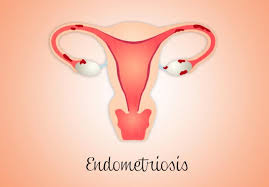Endometriosis
Endometriosis is a disorder in which the tissue that forms the lining of your uterus grows outside of your uterine cavity. The lining of your uterus is called the endometrium.
Endometriosis occurs when the endometrium grows on your ovaries, bowel, and tissues lining your pelvis. It’s unusual for endometrial tissue to spread beyond your pelvic region, but it’s not impossible. Endometrial tissue growing outside of your uterus is known as an endometrial implant.
This tissue trapped in the pelvis can cause:
- irritation
- scar formation
- adhesions, in which tissue binds your pelvic organs together
- severe pain during your periods
- fertility problems
Endometriosis is a common gynecological condition.
Causes
During a regular menstrual cycle, the body sheds the lining of the uterus. This allows menstrual blood to flow from the uterus through the small opening in the cervix and out through the vagina.
Endometriosis often occurs due to a process called retrograde menstruation. This happens when menstrual blood flows back through the fallopian tubes into the pelvic cavity instead of leaving the body.
The displaced endometrial cells then stick to the pelvic walls and the surfaces of your pelvic organs, such as your bladder, ovaries, and rectum. They continue to grow, thicken, and bleed over the course of your menstrual cycle. It’s also possible for the menstrual blood to leak into the pelvic cavity through a surgical scar, such as after a cesarean delivery.
Doctors believe the condition may also occur if small areas of your abdomen convert into endometrial tissue. This may happen because cells in the abdomen grow from embryonic cells, which can change shape and act like endometrial cells.
Stages of Endometriosis
Endometriosis has four stages or types. It can be any of the following:
- minimal
- mild
- moderate
- severe
Different factors determine the stage of the disorder. These factors can include the:
- location
- number
- size
- depth of the endometrial implants
Stage I: Minimal
In minimal endometriosis, there are small lesions, or wounds, and shallow endometrial implants on your ovary. There may also be inflammation in or around your pelvic cavity.
Stage 2: Mild
Mild endometriosis involves light lesions and shallow implants on an ovary and the pelvic lining.
Stage 3: Moderate
Moderate endometriosis involves deep implants on the ovary and pelvic lining. There can also be more lesions.
Stage 4: Severe
The most severe stage of endometriosis involves deep implants on the pelvic lining and ovaries. There may also be lesions on the fallopian tubes and bowels.
SYMPTOMS
- painful periods
- pain in the lower abdomen before and during menstruation
- cramps one or two weeks around menstruation
- heavy menstrual bleeding or bleeding between periods
- infertility
- pain following sexual intercourse
- discomfort with bowel movements
- lower back pain that may occur at any time during your menstrual cycle
HOMOEOPATHIC TREATMENT
Homeopathic medicines used in endometriosis are geared towards altering the activity of the ovaries and therefore slow down the growth of the endometrial tissue. Homeopathic medicines possibly depress the over-secretion of estrogen by the endometrial tissue and hence decrease the disease.

